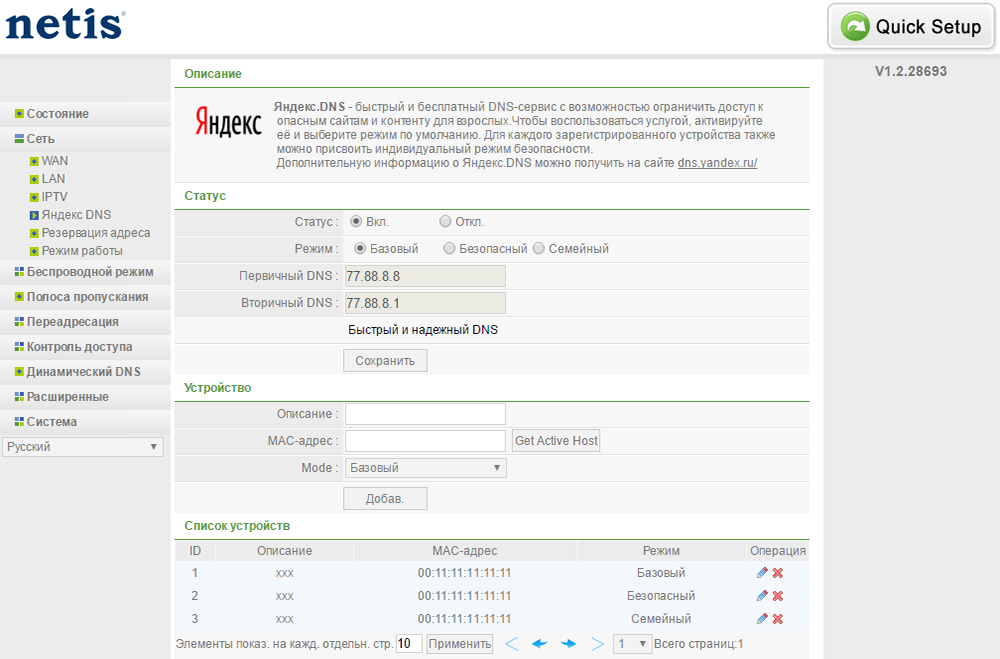With the development of the Internet, users have an incredible number of opportunities. Now everyone can use a computer or other device with access to a network filled with diverse resources for their own purposes. The World Wide Web gave us a lot of entertainment, opportunities to find the right information in a matter of seconds, communication, self-development, learning, earning money in various ways, etc. And everything would be fine, but there were some side effects. The Internet has also opened the way for attackers to deceive in its various manifestations. Since today access to the network is available to everyone, including children, it is worth taking care of the security of the devices from which the connection is made. There are a lot of scammers and other pests, in addition, the Internet is teeming with dangerous content and “adult” materials.

Working with Yandex DNS on different devices.
As you know, the option integrated into Microsoft operating systems is a rather useful tool, but at the same time, all settings come down to restrictions and prohibitions on a child visiting certain resources, although modern children even manage to turn off protection, causing bewilderment of parents. A more advanced version of “parental control” is offered by Yandex. A service called Yandex DNS will protect against the influence of dangerous, virus-infected resources, protect against bots that are tools of intruders, will protect children from sites with pornographic content or other 18+ content, as well as speed up work with sites and will be useful for adult users. In this case, the user does not have to delve into the settings for a long time. Let’s take a closer look at what a service is.
Contents
Yandex.DNS, what is it
DNS (Domain Name System) – literally translated as a domain name system. A free service from a well-known Russian developer is an address book containing the digital addresses of all sites. When opening websites, the Internet browser finds their “place of residence” in DNS, thus, the speed of access to the resource depends on the speed of the nearest server. A tool from Yandex with the ability to select a filtering level allows you to safely visit various sites, since those that contain malicious code or unwanted content will be blocked. You can set up the service for different devices separately, as well as for the router, while protecting all devices connected to the home network.
Three Yandex.DNS operating modes are available for selection:
- Basic, providing speed and reliability (77.88.8.8 and 77.88.8.1);
- Safe, protects against scammers and virus threats (77.88.8.88 and 77.88.8.2);
- Family, protecting from materials 18+ (77.88.8.7 and 77.88.8.3).
The operation of the service is as follows:
- Increase in speed. Yandex owns more than 80 DNS servers located in Russia and abroad. Requests are processed by the server located closest to the user, so websites open much faster with the help of the Yandex.DNS service;
- Protection from sites with dangerous content. Yandex.DNS will protect against sites that can infect a device and scammers who steal money from accounts, passwords and other data. When you go to the site, the service, equipped with its own antivirus, will prevent the download and display a warning message on the screen. Antivirus operates on the basis of Yandex algorithms and Sophos technology;
- Protection against malicious bots. In addition to sites that seek to infect your computer with a virus, another threat thrives on the network – bots that, penetrating into the system of the device, control it. These programs organize networks of devices of unsuspecting users in order to attack servers, steal passwords and send spam messages. To carry out their service, bots connect to the servers that control them, while Yandex.DNS prevents communication with the controlling servers, so that even if the device is infected, the service will be able to cut off the oxygen to pests. Information about the activation of bots is shared with the service by the Virus Tracker system;
- Protection from content 18+. Yandex.DNS protects the youngest users from adult information. Thanks to Yandex search algorithms, web resources containing such content will be identified and not allowed to be viewed.

Setting up Yandex.DNS on a computer
Setting up the service is not difficult to perform and does not require special knowledge and skills from the user. Following the instructions, a beginner will cope with the task. For a computer connected to the network via an Ethernet cable (twisted pair) or the only device where you need to configure, the method with changing the DNS in the network settings is suitable. On different operating systems, the actions are slightly different, but the principle is the same. Consider how to set up Yandex.DNS on a desktop computer or laptop:
- Go to the Network and Sharing Center through the Control Panel;
- In the menu on the left, find and click “Change adapter settings”;
- You can also go to the settings through Start (right-click) – Network connections – Configure adapter settings;
- Depending on the type of connection to the network, on the corresponding tab (local or wireless network connection), right-click the manipulator to display the context menu, where we click “Properties”;
- In the new window, select the IP protocol version 4 (TCP / IPv4) and click “Properties”;
- We put a marker in the column “Use the following DNS address” and enter the preferred DNS below, for example, 77.88.8. (Family mode);
- We press OK.
After these manipulations, the computer will be protected from malicious sites and adult-themed portals.
Sometimes the service overdoes it with protection, you may not be able to access those sites whose security level the filter did not consider sufficient to visit the resource. Or you decide to open access to the “strawberry”, and Yandex. DNS blocks visits to such sites on the computer. You can always remove the filtering by performing the reverse activation of the service. In the properties of the connection protocol, simply remove the marker from the “Use the following IP address” item, rearranging it in the “Obtain an IP address automatically” column. You can also remove one filtering mode and set another one, for which delete the prescribed numbers and drive in those that correspond to the desired Yandex.DNS mode.

Setting up Yandex.DNS on a smartphone
On modern mobile devices, changing DNS settings is also available. Setting up Yandex.DNS on Android is easy:
- Let’s move on to the Wi-fi settings (the menu of smartphones may differ slightly depending on the firmware version, but in general, the actions are similar for different OS variations);
- We are looking for an active access point, press and hold;
- In the menu that appears, select the “Change network” function;
- We put a marker in front of the item “Advanced options”, go down and select “DHCP”, after which we activate the “Static” mode;
- We find “DNS 1” and enter the Yandex DNS (numbers of the filtering mode you have chosen);
- We save the result.
Disabling the Yandex DNS service is performed in the reverse way.

Setting up Yandex.DNS on a wireless Wi-fi adapter
Setting up the filtering service is also easy on the router. After the procedure, the specified filters will be distributed to all devices connected to this network. The settings may differ depending on the router model, but the principle of operation is the same:
- Open device settings;
- We go through authorization (enter login / password);
- Go to Network settings (Network – WAN);
- Check “Use These DNS Servers”;
- Specify the preferred and alternative DNS and save the settings;
- We reboot the device.
Disabling Yandex.DNS on the router is just as easy. To do this, you need to uncheck the box “Use These DNS Servers” (“Use These DNS Servers”) and remove the entered Yandex addresses, if any servers were registered there before making changes, return those numbers to the fields, then save the parameters. Interestingly, Yandex also releases firmware for some router models, where all the necessary settings are already present.
Checking the work of Yandex.DNS
Perhaps, after completing the settings, you will want to make sure that the service is working and the device is really safe, and your child is under control. Checking if a service is running is very easy in practice. Just go, for example, to a site with a “strawberry” (if the Family mode is selected). Instead of the portal content, you will see a message from Yandex.DNS telling you about adult content and the prohibition of displaying pages with such content. The service is quite good and cases of hitting a resource that does not have any hint of villainy in the form of a virus or pornography are rare. The settings are simple and are performed without the involvement of third-party software. And most importantly, with the help of Yandex.DNS, you can protect your own, as well as your children’s devices, from attacks by viruses + protect minors from information they do not need.